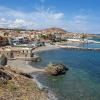300 HP (221 kW) @ 5250 /min
535 Nm @ 3500 /min
Could this be the fact?? I mean, I thought that rally cars use RPM with much higher values than just 5250 /min (8000 /min came into mind). Is it possible, that a four cylinder 2000 cc engine could produce (eventhough I know there is turbocharger inside)?
And, while speaking of this: could anyone tell me, at which RPM did Group B cars achieve highest power and torque, and how high does values were?
Thank you in advance.














